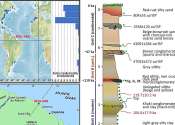S. Korea says second spy satellite placed in orbit
South Korea put its second domestically made spy satellite into orbit, Seoul's defense ministry said Monday, after it launched from an American space center on a SpaceX Falcon 9 rocket.

South Korea put its second domestically made spy satellite into orbit, Seoul's defense ministry said Monday, after it launched from an American space center on a SpaceX Falcon 9 rocket.
Space Exploration
Apr 8, 2024
0
1

In what is an intriguing mix of past and future, an international team of researchers, including some from the University of Bonn, has stumbled upon a surprising window to the past in Kourou in French Guiana. In the clay ...
Paleontology & Fossils
Mar 26, 2024
0
195

Operational modal analysis (OMA) techniques have been used to identify the modal characteristics of the Artemis I launch vehicle during the Dynamic Rollout Test (DRT) and Wet Dress Rehearsal (WDR) configuration prior to launch. ...
Space Exploration
Mar 12, 2024
0
1

A historic private mission to land on the moon faced near-certain failure Monday after the spacecraft suffered a "critical loss" of fuel, dealing a major blow to America's hopes of placing its first robot on the lunar surface ...
Space Exploration
Jan 8, 2024
4
11

GOES-U, the fourth and final satellite in NOAA's GOES-R Series of advanced geostationary satellites, recently completed rigorous testing to ensure it can withstand the harsh conditions of launch and orbiting in space 22,236 ...
Space Exploration
Sep 15, 2023
0
1

Validation testing continues for ESA's all-new Ariane 6 launch vehicle, with firing of its two upper stage engines to simulate the way they will have to operate together during a flight.
Space Exploration
Sep 4, 2023
0
34

The first rocket launch from the surface of another planet will be accomplished using two solid rocket motors.
Space Exploration
Jul 31, 2023
0
35

While the next humans to fly to the moon will rely on the Orion spacecraft for the nearly half-million-mile trip next year on the Artemis II mission, the final 9 miles to the launch pad will come while riding in one of three ...
Space Exploration
Jul 13, 2023
0
2

NASA will test a new capability for supporting science research in the mesosphere with the launch of two rockets from NASA's Wallops Flight Facility, Virginia on Feb. 9, 2023. The two Improved-Orion suborbital sounding rockets ...
Planetary Sciences
Feb 3, 2023
0
4

Researchers report new results from the NASA Deep Space Optical Communications (DSOC) technology demonstration project, which develops and tests new advanced laser sources for deep-space optical communication. The ability ...
Astronomy
Dec 9, 2022
0
59
In spaceflight, a launch vehicle or carrier rocket is a rocket used to carry a payload from the Earth's surface into outer space. A launch system includes the launch vehicle, the launch pad and other infrastructure. Usually the payload is an artificial satellite placed into orbit, but some spaceflights are sub-orbital while others enable spacecraft to escape Earth orbit entirely. A launch vehicle which carries its payload on a suborbital trajectory is often called a sounding rocket.
This text uses material from Wikipedia, licensed under CC BY-SA